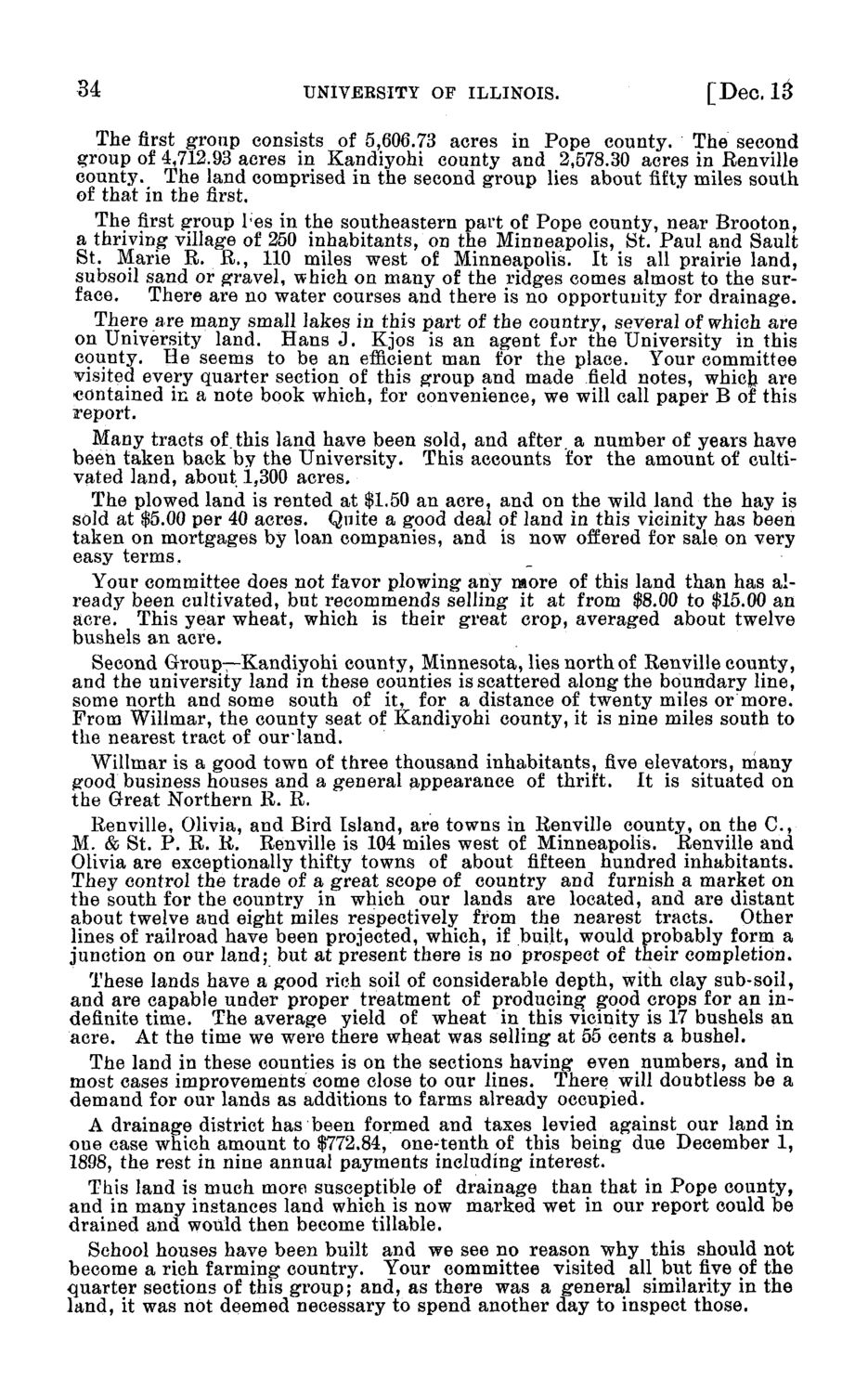| |
| |
Caption: Board of Trustees Minutes - 1900
This is a reduced-resolution page image for fast online browsing.

EXTRACTED TEXT FROM PAGE:
34 UNIVERSITY OF ILLINOIS. [ D e c . it The first group consists of 5,606.73 acres in Pope county. The second group of 4,712.93 acres in Kandiyohi county and 2,578.30 acres in Renville county. The land comprised in the second group lies about fifty miles south of that in the first. The first group l e s in the southeastern part of Pope county, near Brooton, a thriving village of 250 inhabitants, on the Minneapolis, St. Paul and Sault St. Marie R. R., 110 miles west of Minneapolis. It is all prairie land, subsoil sand or gravel, which on many of the ridges comes almost to the surface. There are no water courses and there is no opportunity for drainage. There are many small lakes in this rjart of the country, several of which are on University land. Hans J. Kjos is an agent for the University in this county. He seems to be an efficient man for the place. Your committee visited every quarter section of this group and made field notes, whicb are •contained in a note book which, for convenience, we will call paper B or this report. Many tracts of.this land have been sold, and after a number of years have been taken back by the University. This accounts for the amount of cultivated land, about 1,300 acres. The plowed land is rented at $1.50 an acre, and on the wild land the hay is sold at $5.00 per 40 acres. Quite a good deal of land in this vicinity has been taken on mortgages by loan companies, and is now offered for sale on very easy terms. Your committee does not favor plowing any more of this land than has already been cultivated, but recommends selling it at from $8.00 to $15.00 an acre. This year wheat, which is their great crop, averaged about twelve bushels an acre. Second Group—Kandiyohi county, Minnesota, lies north of Renville county, and the university land in these counties is scattered along the boundary line, some north and some south of it, for a distance of twenty miles or more. From Willmar, the county seat of Kandiyohi county, it is nine miles south to the nearest tract of our land. Willmar is a good town of three thousand inhabitants, five elevators, many good business houses and a general appearance of thrift. It is situated on the Great Northern R. R. Renville, Olivia, and Bird Island, are towns in Renville county, on the C , M. & St. P. R. R. Renville is 104 miles west of Minneapolis. Renville and Olivia are exceptionally thifty towns of about fifteen hundred inhabitants. They control the trade of a great scope of country and furnish a market on the south for the country in which our lands are located, and are distant about twelve and eight miles respectively from the nearest tracts. Other lines of railroad have been projected, which, if built, would probably form a junction on our land; but at present there is no prospect of their completion. These lands have a good rich soil of considerable depth, with clay sub-soil, and are capable under proper treatment of producing good crops for an indefinite time. The average yield of wheat in this vicinity is 17 bushels an acre. At the time we were there wheat was selling at 55 cents a bushel. The land in these counties is on the sections having even numbers, and in most cases improvements come close to our lines. There will doubtless be a demand for our lands as additions to farms already occupied. A drainage district has been formed and taxes levied against our land in oue case which amount to $772.84, one-tenth of this being due December 1, 1898, the rest in nine annual payments including interest. This land is much more susceptible of drainage than that in Pope county, and in many instances land which is now marked wet in our report could be drained and would then become tillable. School houses have been built and we see no reason why this should not become a rich farming country. Your committee visited all but five of the quarter sections of this group; and, as there was a general similarity in the land, it was not deemed necessary to spend another day to inspect those.
| |